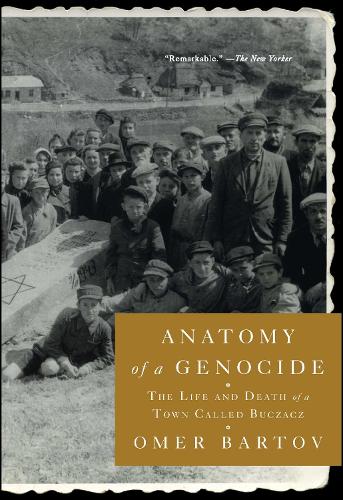
Anatomy of a Genocide: The Life and Death of a Town Called Buczacz
(Paperback)
Publishing Details
Anatomy of a Genocide: The Life and Death of a Town Called Buczacz
By (Author) Omer Bartov
Simon & Schuster
Simon & Schuster
1st January 2019
United States
Classifications
General
Non Fiction
European history
History and Archaeology
940.531809477
Physical Properties
Paperback
416
Width 140mm, Height 213mm, Spine 28mm
372g
Description
Winner of the Yad Vashem International Book Book Prize for Holocaust Research
A substantive contribution to the history of ethnic strife and extreme violence (The Wall Street Journal) and a cautionary examination of how genocide can take root at the local levelturning neighbors, friends, and family against one anotheras seen through the eastern European border town of Buczacz during World War II.
For more than four hundred years, the Eastern European border town of Buczacztoday part of Ukrainewas home to a highly diverse citizenry. It was here that Poles, Ukrainians, and Jews all lived side by side in relative harmony. Then came World War II, and three years later the entire Jewish population had been murdered by German and Ukrainian police, while Ukrainian nationalists eradicated Polish residents. In truth, though, this genocide didnt happen so quickly.
In Anatomy of a Genocide, Omer Bartov explains that ethnic cleansing doesnt occur as is so often portrayed in popular history, with the quick ascent of a vitriolic political leader and the unleashing of military might. It begins in seeming peace, slowly and often unnoticed, the culmination of pent-up slights and grudges and indignities. The perpetrators arent just sociopathic soldiers. They are neighbors and friends and family. They are also middle-aged men who come from elsewhere, often with their wives and children and parents, and settle into a life of bourgeois comfort peppered with bouts of mass murder.
For more than two decades Bartov, whose mother was raised in Buczacz, traveled extensively throughout the region, scouring archives and amassing thousands of documents rarely seen until now. He has also made use of hundreds of first-person testimonies by victims, perpetrators, collaborators, and rescuers. Anatomy of a Genocide profoundly changes our understanding of the social dynamics of mass killing and the nature of the Holocaust as a whole. Bartovs book isnt just an attempt to understand what happened in the past. Its a warning of how it could happen again, in our own towns and citiesmuch more easily than we might think.
Reviews
"Mr. Bartovs anatomy of genocidal destruction is a monument of a different sort. It is an act of filial piety recollecting the blood-soaked homeland of his parents; it is a substantive contribution to the history of ethnic strife and extreme violence; it is a harrowing reminder that brutality and intimacy can combine to destroy individual lives and reshape the destiny of a region and its peoples: history as recollection and as warning."
Wall Street Journal
"Fascinating...This resonant and cautionary history demonstrates how the peace was incrementally disrupted, as rage accumulated and neighbors and friends felt pitted against one another."
Los Angeles Times
"If you imagined there might be no more to learn, alongcomes this work of forensic, gripping, original, appalling brilliance."
Philippe Sands, author of East WestStreet: On the Origins of "Genocide" and "Crimes Against Humanity"
"Combines a long historical perspective with an intimate reconstruction of who the perpetrators and victims of the Holocaust had been. A local history opening ourunderstanding of the phenomenon at large. A brilliant book by a master historian."
Jan T. Gross, author of Neighbors: The Destruction of the Jewish Community in Jedwabne, Poland
"This is a gripping, challenging, and masterfully written book...Understanding the destruction of the Jews as part of genocidal perils that have not passed even today, the horrific case of Buczacz thus comes as a powerful warning against bigotry everywhere at any time."
Tom Segev, author of The Seventh Mllion: The Israelis and the Holocaust and Simon Wiesenthal:The Life and Legends
"Omer Bartov's masterful study of Buczacz marked by comprehensive scholarship and a compelling narrative exemplifies the very best in current Holocaust history writing."
Christopher R. Browning, author of Ordinary Men: Reserve Police Battalion 101 and the Final Solution in Poland
"A long-awaited and essential contribution to the history of the Holocaust. This thoroughly researched and beautifully written study of the deep roots and immediate circumstances of genocide in an East Galician multiethnic town...is an exemplary microhistory of the Holocaust, a model for future research."
Saul Friedlander, author of Nazi Germany and the Jews
"The result is breathtaking, painful and astonishing"
The Spectator
"Bartovs book is a significant contribution to the holocaust literature. However, the books contribution is even more significant in understanding the complexity of interethnic conflicts...Anatomy of a Genocide furnishes well-lit imagination, though shaded with sadness, beneficial for the communities trapped into mutual impairment in various parts of the world, including Chechnya, Palestine, Kashmir, Burundi, and Rwanda."
New York Journal of Books
"Fascinating...This resonant and cautionary history demonstrates how the peace was incrementally disrupted, as rage accumulated and neighbors and friends felt pitted against one another."
National Book Review
"At once a scholarly and a personal book."
Jerusalem Post
"Remarkable."
The New Yorker
Author Bio
Omer Bartov is the John P. Birkelund Distinguished Professor of European History at Brown University. He is the author ofAnatomy of a Genocide: The Life and Death of a Town Called Buczacz, along with several other well-respected scholarly works on the Holocaust and genocide, includingGermanys War and the Holocaust: Disputed HistoriesandErased: Vanishing Traces of Jewish Galicia in Present-Day Ukraine. He has written forThe New Republic,The Wall Street Journal, The Nation,andThe New York Times Book Review. He lives in Cambridge, Massachusetts.
